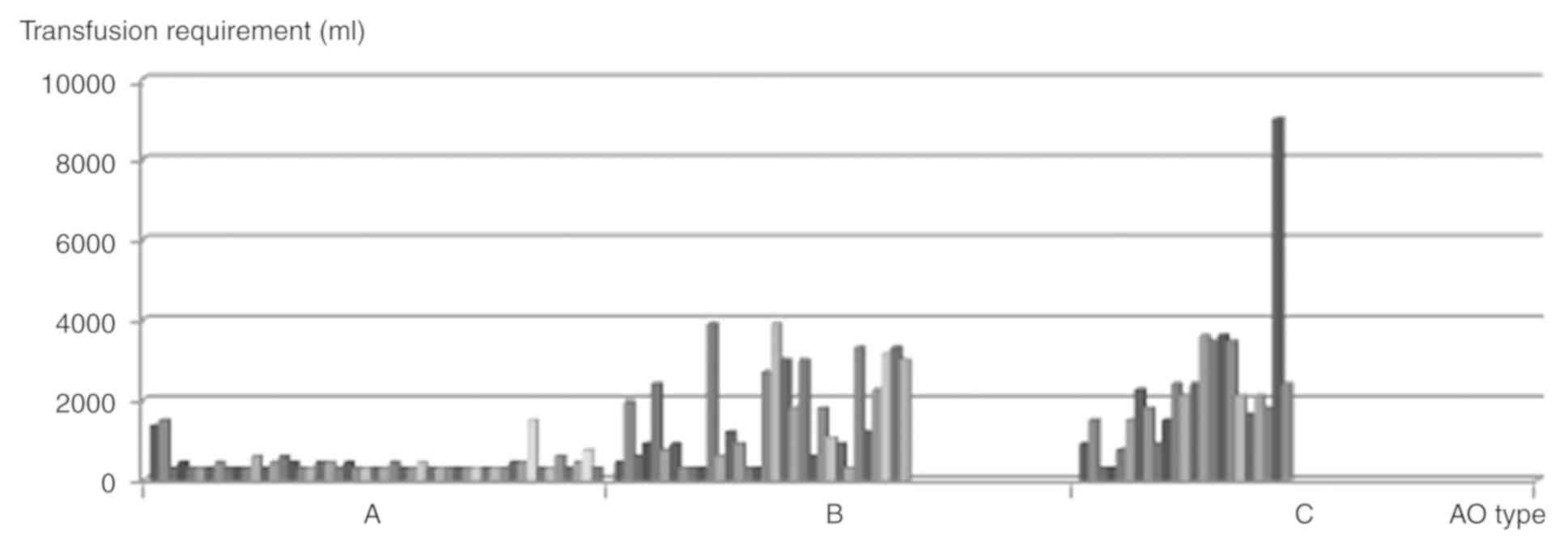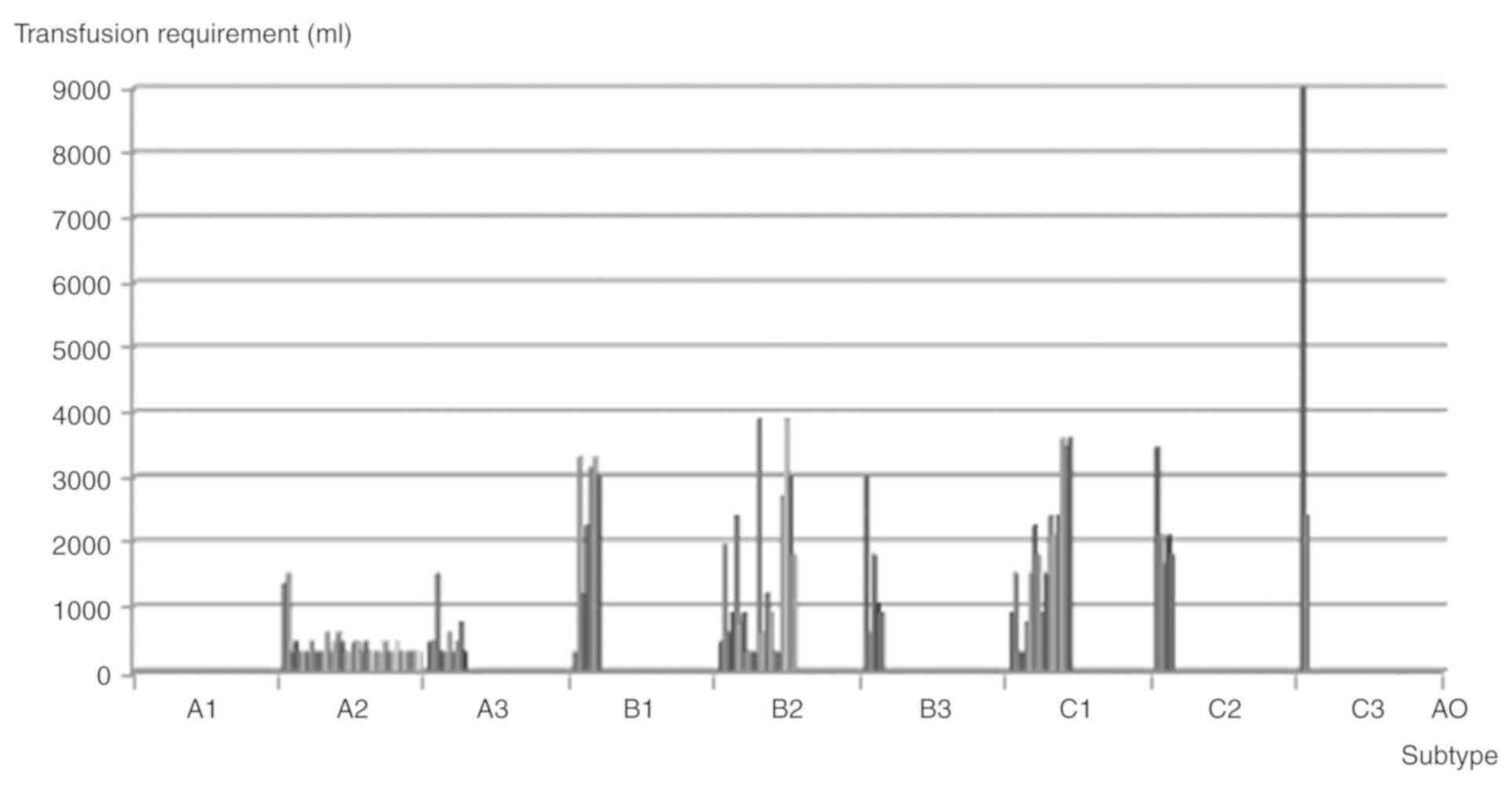|
1
|
Paydar S, Chaabi M, Akhavan M, Ghahramani
Z and Dehghankhalili M: Outcome determinants of patients with
traumatic pelvic fractures: A cohort study in a level i trauma
center in southern iran. Malays Orthop J. 11:23–30. 2017.
View Article : Google Scholar : PubMed/NCBI
|
|
2
|
Rehwald R, Schönherr E, Petersen J, Jeske
HC, Fialkovska A, Luger AK, Grams AE, Loizides A, Jaschke W and
Glodny B: Prognostic factors in endovascular treated pelvic
haemorrhage after blunt trauma. BMC Surg. 17:892017. View Article : Google Scholar : PubMed/NCBI
|
|
3
|
Burgess AR, Eastridge BJ, Young JW,
Ellison TS, Ellison PS Jr, Poka A, Bathon GH and Brumback RJ:
Pelvic ring disruptions: Effective classification system and
treatment protocols. J Trauma. 30:848–856. 1990. View Article : Google Scholar : PubMed/NCBI
|
|
4
|
Starr AJ, Griffin DR, Reinert CM, Frawley
WH, Walker J, Whitlock SN, Borer DS, Rao AV and Jones AL: Pelvic
ring disruptions: Prediction of associated injuries, transfusion
requirement, pelvic arteriography, complications, and mortality. J
Orthop Trauma. 16:553–561. 2002. View Article : Google Scholar : PubMed/NCBI
|
|
5
|
Dalal SA, Burgess AR, Siegel JH, Young JW,
Brumback RJ, Poka A, Dunham CM, Gens D and Bathon H: Pelvic
fracture in multiple trauma: Classification by mechanism is key to
pattern of organ injury, resuscitative requirements, and outcome. J
Trauma. 29:981–1002. 1989. View Article : Google Scholar : PubMed/NCBI
|
|
6
|
Papadopoulos IN, Kanakaris N, Bonovas S,
Triantafillidis A, Garnavos C, Voros D and Leukidis C: Auditing 655
fatalities with pelvic fractures by autopsy as a basis to evaluate
trauma care. J Am Coll Surg. 203:30–43. 2006. View Article : Google Scholar : PubMed/NCBI
|
|
7
|
Chen TW, Yang ZG, Dong ZH, Tang SS, Chu ZG
and Shao H: Earthquake-related pelvic crush fracture vs.
non-earthquake fracture on digital radiography and MDCT: A
comparative study. Clinics (Sao Paulo). 66:629–634. 2011.
View Article : Google Scholar : PubMed/NCBI
|
|
8
|
Eastridge BJ, Starr A, Minei JP, O'Keefe
GE and Scalea TM: The importance of fracture pattern in guiding
therapeutic decision-making in patients with hemorrhagic shock and
pelvic ring disruptions. J Trauma. 53:446–451. 2002. View Article : Google Scholar : PubMed/NCBI
|
|
9
|
Vaidya R, Waldron J, Scott A and Nasr K:
Angiography and embolization in the management of bleeding pelvic
fractures. J Am Acad Orthop Surg. 26:e68–e76. 2018. View Article : Google Scholar : PubMed/NCBI
|
|
10
|
Hussami M, Grabherr S, Meuli RA and
Schmidt S: Severe pelvic injury: Vascular lesions detected by ante-
and post-mortem contrast medium-enhanced CT and associations with
pelvic fractures. Int J Legal Med. 131:731–738. 2017. View Article : Google Scholar : PubMed/NCBI
|
|
11
|
Burlew CC, Moore EE, Stahel PF, Geddes AE,
Wagenaar AE, Pieracci FM, Fox CJ, Campion EM, Johnson JL and
Mauffrey C: Preperitoneal pelvic packing reduces mortality in
patients with life-threatening hemorrhage due to unstable pelvic
fractures. J Trauma Acute Care Surg. 82:233–242. 2017. View Article : Google Scholar : PubMed/NCBI
|
|
12
|
Magnussen RA, Tressler MA, Obremskey WT
and Kregor PJ: Predicting blood loss in isolated pelvic and
acetabular high-energy trauma. J Orthop Trauma. 21:603–607. 2007.
View Article : Google Scholar : PubMed/NCBI
|
|
13
|
Blackmore CC, Jurkovich GJ, Linnau KF,
Cummings P, Hoffer EK and Rivara FP: Assessment of amount of
hemorrhage and outcome from pelvic fracture. Arch Surg.
138:504–509. 2003. View Article : Google Scholar : PubMed/NCBI
|
|
14
|
Blackmore CC, Cummings P, Jurkovich GJ,
Linnau KF, Hoffer EK and Rivara FP: Predicting major hemorrhage in
pelvic fracture. J Trauma. 61:346–352. 2006. View Article : Google Scholar : PubMed/NCBI
|
|
15
|
Marsh JL, Slongo TF, Agel J, Broderick JS,
Creevey W, DeCoster TA, Prokuski L, Sirkin MS, Ziran B, Henley B
and Audigé L: Fracture and dislocation classification compendium
−2007: Orthopaedic trauma association classification, database and
outcomes committee. J Orthop Trauma. 21 (10 Suppl):S1–S133. 2007.
View Article : Google Scholar : PubMed/NCBI
|
|
16
|
Association for the Advancement of
Automotive Medicine (AAAM), . The abbreviated injury scale
(AIS)-1990 revision. AAAM. (Chicago, IL). 11–15. 1990.
|
|
17
|
Baker SP, O'Neill B, Haddon W Jr and Long
WB: The injury severity score: A method for describing patients
with multiple injuries and evaluating emergency care. J Trauma.
14:187–196. 1974. View Article : Google Scholar : PubMed/NCBI
|
|
18
|
American College of Surgeons Committee on
Trauma, . Advanced Trauma Life Support for Doctors. American
College of Surgeons. (Chicago, IL). 2004.
|
|
19
|
Lal DS and Shaz BH: Massive transfusion:
Blood component ratios. Curr Opin Hematol. 20:521–525. 2013.
View Article : Google Scholar : PubMed/NCBI
|
|
20
|
Miller PR, Moore PS, Mansell E, Meredith
JW and Chang MC: External fixation or arteriogram in bleeding
pelvic fracture: Initial therapy guided by markers of arterial
hemorrhage. J Trauma. 54:437–443. 2003. View Article : Google Scholar : PubMed/NCBI
|
|
21
|
Tang CH, Shivji F and Forward D: Major
haemorrhage in pubic rami fractures. BMJ Case Rep.
bcr20142080882015. View Article : Google Scholar : PubMed/NCBI
|
|
22
|
Hamill J, Holden A, Paice R and Civil I:
Pelvic fracture pattern predicts pelvic arterial hemorrhage. Aust N
Z J Surg. 70:338–343. 2000. View Article : Google Scholar : PubMed/NCBI
|
|
23
|
Barratt RC, Bernard J, Mundy AR and
Greenwell TJ: Pelvic fracture urethral injury in males-mechanisms
of injury, management options and outcomes. Transl Androl Urol. 7
(Suppl 1):S29–S62. 2018. View Article : Google Scholar : PubMed/NCBI
|
|
24
|
Jang JY, Shim H, Jung PY, Kim S and Bae
KS: Preperitoneal pelvic packing in patients with hemodynamic
instability due to severe pelvic fracture: Early experience in a
Korean trauma center. Scand J Trauma Resusc Emerg Med. 24:32016.
View Article : Google Scholar : PubMed/NCBI
|
|
25
|
Sarin EL, Moore JB, Moore EE, Shannon MR,
Ray CE, Morgan SJ and Smith WR: Pelvic fracture pattern does not
always predict the need for urgernt embolization. J Trauma.
58:973–977. 2005. View Article : Google Scholar : PubMed/NCBI
|
|
26
|
Osterhoff G, Scheyerer MJ, Fritz Y,
Bouaicha S, Wanner GA, Simmen HP and Werner CM: Comparing the
predictive value of the pelvic ring injury classification systems
by Tile and by Young and Burgess. Injury. 45:742–747. 2014.
View Article : Google Scholar : PubMed/NCBI
|
|
27
|
Gustavo Parreira J, Coimbra R, Rasslan S,
Oliveira A, Fregoneze M and Mercadante M: The role of associated
injuries on outcome of blunt trauma patients sustaining pelvic
fractures. Injury. 31:677–682. 2000. View Article : Google Scholar : PubMed/NCBI
|
|
28
|
Hasankhani EG and Omidi-Kashani F:
Treatment outcomes of open pelvic fractures associated with
extensive perineal injuries. Clin Orthop Surg. 5:263–268. 2013.
View Article : Google Scholar : PubMed/NCBI
|
|
29
|
Coccolini F, Stahel PF, Montori G, Biffl
W, Horer TM, Catena F, Kluger Y, Moore EE, Peitzman AB, Ivatury R,
et al: Pelvic trauma: WSES classification and guidelines. World J
Emerg Surg. 12:52017. View Article : Google Scholar : PubMed/NCBI
|
|
30
|
Jovanovic B, Milan Z, Djuric O,
Markovic-Denic L, Karamarkovic A, Gregoric P, Doklestic K,
Avramovic J, Velickovic J and Bumbasirevic V: Twenty-eight-day
mortality of blunt traumatic brain injury and co-injuries requiring
mechanical ventilation. Med Princ Pract. 25:435–441. 2016.
View Article : Google Scholar : PubMed/NCBI
|
















